The Terry Alt Movement 1829-31 by James S. Donnelly, Jr.
Published in
18th-19th Century Social Perspectives,
18th–19th - Century History,
Features,
Issue 4 (Winter 1994),
Volume 2
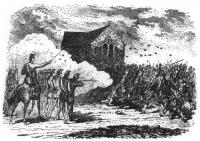
The Battle (fromTrench’s Realities of Irish Life)
The Terry Alt movement of 1828-31 has been one of I the least studied of pre-Famine rural revolts, partly because it was dwarfed by the great anti-tithe agitation with which it temporarily shared the stage at the outset of the 1830s.
The name itself is obscure. According to the traveller John Barrow, writing in 1836, ‘the individual whose name they assumed is a most harmless and inoffensive man, and .. .it arose from these marauders, perhaps out of sport than malice, when on their predatory attacks, being in the habit of crying out-“Well done, Terry!Well done, Terry Alt!'” At its peak it was similar to a volcanic eruption, with a gradual accumulation of pressure before a great explosion in the late winter and spring of 1830-31 and a quick subsidence into orderly quiet thereafter. During its explosive phase and in its heartland of County Clare, it was marked by a level of activity and a degree of popular mobilisation that were probably unprecedented. In its causes it was a rich and complex mixture of economic distress, sectarian hostilities, and political antagonisms. What was most unusual was the impact of formal parliamentary politics. Lastly, in its characteristic form of protest (the turning up of pasture land by large crowds), the Terry Alt movement was open and communal to an extraordinary extent. Though clandestine-nocturnal activity remained important throughout-what was most striking to contemporary observers were the great daytime gatherings of diggers and sod-breakers, cheered on by large, enthusiastic
Disastrous harvests
In the late summer of 1829 torrential rains, followed by severe flooding, heavily damaged the grain and potato crops. In many regions the potato crop was said to be ‘quite blasted’, and Clare was reportedly among the counties where the inundations were at their worst. Food was scarce and dear in the spring and summer of 1830, with much suffering among the poor and no relief at harvest time. Rain again poured down in torrents in the last four months of 1830, making it ‘the wettest year ever remembered in the west’. Again, crop deficiencies brought high food prices and acute distress during the first half and more of 1831. In themselves these conditions were calculated to spark agrarian unrest. Especially likely was class conflict between those who hired potato ground (agricultural labourers, farm servants and cottiers) and those who controlled it (larger farmers, graziers and proprietors). What added to the pressure felt by the poor were the rising land values of the mid and late 1820s, which meant that by 1829 the burden of conacre rents was especially heavy. And aggravating other economic problems was the elemental force of rapid population growth in the west.
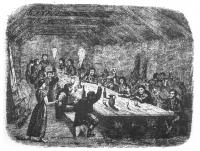
The Trial by Jury (from Trench’s Realities of Irish Life).
Five contested elections in four years
Against this disheartening background of economic troubles there occurred an extraordinary amount of formal political activity, penetrating to the depths of Catholic rural society in Clare. The general elections of 1830, 1831, and 1832 were contested. In addition there were two contested by-elections. In July 1828, Daniel O’Connell, the revolting forty shilling freeholders and the Catholic clergy overwhelmed the Protestant (though pro-emancipationist) candidate William Vesey-Fitzgerald. Since O’Connell had always proclaimed that he would never take the anti-Catholic oaths required of MPs, his election was officially declared void. But after emancipation (with its acceptable oath) was won, O’Connell was returned to parliament for Clare without opposition in July 1829. Even though there was no contest this time, the proceedings
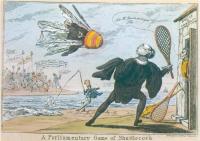
Satirical cartoon of the Clare by-election in 1828 – The Speaker of the House of Commons preparing to use the Oath of Allegiance (his racket) to prevent
O’Connell (on the shuttlecock) from taking
his seat in the Commons.
at Ennis were peaceably tumultuous, with the ‘Liberator’ being escorted into the town by a huge throng estimated at 40,000 people. The second contested by-election became necessary when the O’Gorman Mahon, returned for Clare in the general election of 1830, was unseated on petition because of well-founded charges of bribery. The ensuing by-election was won handily in March 1831 by Maurice O’Connell, the Liberator’s eldest son. But only two months later, in a general election, the O’Gorman Mahon waged a furious antiO’Connellite campaign and came within about 100 votes of unseating Maurice O’Connell. This was one of the most bizarre county elections in modern Irish history. It took place almost at the height of the Terry Alt disturbances, and even though the freehold qualification for voting was now £10, thus largely excluding the rural poor, the O’Gorman Mahon presented himself as a staunch friend of the agrarian rebels. Through the assistance of the Terry Alts, the agents of the O’Gorman Mahon arranged for threatening notices to be served on numerous £10 freeholders and for oaths to be administered, requiring them to vote for him. He was also said to have traded on his recent declaration in parliament that he had himself been a member of a secret society for nearly twelve years. It is unlikely that he did much more than try to reap electoral advantage from the Terry Alt movement, although O’Connell was pre-pared to lay graver charges. He informed the Irish chief secretary early in May 1831 that the O’Gorman Mahon had been ‘before his last election, for more than twelve months countenancing the progress of the Terry Alt combination, the oaths, the meetings, etc . .’ In so doing, declared O’Connell, he had ‘given a strength, a permanency, and a consistency to this organisation which no other within my memory ever had’.
Terry Alts stimulated by electioneering
The exuberant and prolonged electioneering of 1828-31 stimulated the Terry Alts in numerous ways. The great struggle for emancipation and its achievement in 1829 demonstrated the power of popular political mobilisation, the value of organisation and discipline, and the effectiveness of the threat of phySical force. Victory, even if only of symbolic importance at the popular level, provided an enormous psychological uplift. Soon after the movement had spread into County Limerick in April 1831 a local Protestant observed that: ‘The great machinery of political agitation which the clergy worked with such effect is now reacting against themselves, for the people have been taught their own strength, and now they seem resolved to use it as they think fit, without consulting their teachers.’ Priests who condemned the Terry Alts were likely to incur severe popular displeasure.
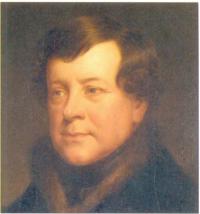
Daniel O’Connell by Mulvany. (COURTESY
OF THE NATIONAL GALLERY OF IRELAND)
Playing the Catholic card
O’Connell had effectively played the Catholic card in his campaign against Vesey-Fitzgerald, whom he stigmatised as ‘the sworn libeller of the Catholic faith’. The sectarianism which marked that famous by-election was carried over into the initial phase of the Terry Alt movement. Among the sins of a Lisdoonvarna resident threatened by the Terry Alts was his vote for Vesey-Fitzgerald and ‘Brunswick principles’, his neglect of ‘the religion of his ancestors’, and the disrespect that he had shown to ‘his true pastor and priest’. In another Terry Alt notice the Anglican curate of Kilkeedy was warned ‘to cease associating with Brunswickers and interfering in Protestant affairs, or he might expect to suffer’. The oaths in circulation also contained sectarian provisions, such as the pledge not to ‘buy one pound of any kind of value from any Orange man or Protestant, while there is as good value from a Catholic’. Exclusive dealing, long a staple of Irish politiCS, was also applied to employers of the wrong politics (and often the wrong religion as well): ‘the people through the country [it was reported] are sworn not to work for any person that did not vote for O’Connell’. Intensifying the sectarianism of Clare politics and injecting its intolerant spirit into the incipient agrarian rebellion was a bitter struggle against local manifestations of the so-called Second Reformation. In May 1829, in what was not an isolated incident, a schoolhouse connected with the Baptist SOCiety, a Protestant proselytising body, was burned to the ground in the parish of O’Gonnelloe. But by far the greatest lightning rods for such attacks were the tenants and employees of Edward Synge of Carhoo near Corofin. Synge had established a series of scriptural schools on his estate at Rath in the Corofin district and elsewhere. He strongly encouraged his tenants to send their children to these schools, but countervailing pressure was applied. Not only was one of his schools burned down, but in addition, according to Synge, on 20 June 1829 ‘almost the whole population’ of his Rath estate ‘were marched into Ennis to declare that they had renounced all connection with the school’. Forced to head the parade were those tenants who had promised in the autumn of 1828, after visits from ‘gangs of liberators’, that they would withdraw their children, but who later allowed them to attend again, despite the O’Connell medals they were given for use ‘as passes at fairs and markets’. On the following day, a Sunday, many of the tenants were required to attend a Catholic chapel where they enrolled their names on a list of non-supporters of the school. A second Iist-of supporters- was also prepared, ‘avowedly for the purpose of their being precluded from all social intercourse and marked for persecution at fair and market’. Persecuted the recalcitrant tenants certainly were: two were waylaid and assaulted following the Ennistymon fair; four more were beaten at the Turloughmore fair; the cattle of others were maimed; and two had their houses burned. Under this barrage the tenants, or at least most of them, procured others to conduct their business at fairs, sat up at night to protect themselves against raids, and withdrew their children from the schools. The local authorities were dismayed by Synge’s provocative activities and tried to persuade him to abandon proselytism ‘for the present’, but without any success. As a result, the campaign against his compliant tenants, his labourers, and Synge himself persisted-with boycotting, beatings, and damage to property-through the summer and autumn of 1829.
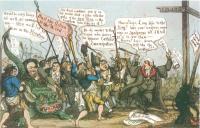
O’Connell and his followers waiting for Emancipation to loose the dragon of persecution on Protestant heretics.
The murder of William Blood
There was a close connection in personnel between this sectarian violence on Synge’s estate in 1829 and the incident which ignited the explosive phase of the Terry AIt movement early in 1831. Among the local leaders of the campaign against Synge were the four Casey brothers: they were also principals in the murder of William Blood on 21 January 183l. Blood was a land agent employed by Lord Stradbroke. He was killed by a party of six men (five strangers and one of his own servants) inside his own residence at Applevale near Corofin. Although local grievances probably played a role in his murder, Blood had long been notorious for his association with a large number of evictions-a true clearance, complete with the tumbling of cabins-on Lord Stradbroke’s estate at Bilboa in Limerick in the early 1820s. At that time there had been violent reprisals for the clearance, and the murder of Blood, it seems, was yet another act of revenge. For their alleged role in the murder George and Michael Casey were eventually executed. In the months prior to the killing of Blood, neither the Corofin area nor other districts of Clare had been highly disturbed by agrarian violence. It was not until mid-December of 1830 that the local newspaper, the Ennis Chronicle and Clare Advertiser, mentioned a specific agrarian outrage in the county. Until Blood’s murder, the scale of activity was fairly low and geographically isolated.
Volcanic eruption
Then came the volcanic eruption. The number of recorded offences in Clare increased from 99 in January 1831 to 204 in February, and that was only the beginning. In March the number quadrupled to 807, and in April it reached 1,103. In May the pace began to slacken, and thereafter, in the face of military and judicial repression, the volcano was stilled. Of the 3,280 offences recorded in Clare in 1831, as many as 2,912, or eighty-nine per cent, occurred during the first five months of the year. Though concentrated within a shorter time and a smaller area, the scale of the unrest in Clare and adjoining counties was comparable to that of the ‘Captain Swing’ revolt that occurred in England at about the same time. From its original seat in the Corotin district of Inchiquin barony, the Terry Alt movement almost immediately spilled over into the neighbouring barony of Burren. Inchiquin and Burren were both notable for their large areas of grazing. Already in 1808, when Hely Dutton published his Statistical Survey of the County of Clare, for every acre that was devoted to grain crops in Inchiquin, eight acres were left in grass for cattle and sheep, and in Burren, with its great sheep walks, the balance in favour of pasture was even more lopsided. But the movement was not confined to these areas. At its peak in the spring of 1831, it extended into almost all of Clare’s nine baronies as well as into south Galway,large parts of Limerick, and a much smaller portion of Tipperary.
Comprehensive statistics
The Terry Alt movement in Clare in 1831 was the first in the pre-Famine period for which we possess a comprehensive set of official statistics covering the gamut of rebel activity. Personal violence was greatly in evidence. Most of the nineteen homicides committed between January and May were directly connected with the movement. Besides William Blood, four other estate employees were killed, as were five policemen and a soldier. Still more numerous were beatings-201 assaults ‘connect ed with Ribbonism’ from January through May. The most common victims were herds who guarded pastures and labourers who worked for proscribed employers or who were considered strangers to the locality where they worked. The beatings were generally administered by small Terry Alt bands operating at”night. Nocturnal attacks on the houses of their enemies were officially the second most common Terry Alt offence, accounting for 397 cases from January through May, but to them should be added many incidents assigned to other categories. The purpose of a very high proportion of the raids on houses was to secure arms. In the first five months of 1831 the authorities recorded 288 cases of the robbery of arms and 100 cases of ‘demanding arms’. Another frequent object of these attacks, besides the tendering of oaths (303 cases), was the levying of contributions. Like their predecessors, the Terry Alts used the money to buy arms and ammunition, to fee lawyers and bribe witnesses when their comrades faced trial, or simply to augment their meagre incomes. The frequency of this practice of demanding money probably accounts for many of the 227 cases of robbery and burglary recorded by the authorities between January and May. But while the raiding of houses was the most common Terry Alt crime (in fact, if not officially), most activity was designed to Increase the availability of potato ground and to lower its price. The pursuit of these goals entailed both nocturnal and daytime operations. By night, small bands destroyed the fences and walls that enclosed pastures and drove off the livestock that grazed there. At the height of the movement between March and May 1831, the authorities in Clare recorded 132 cases of the levelling of walls and fences. But still more frequent was the turning up of grassland by crowds in the daytime. It was this frenzied activity which made ‘illegal meetings’ officially the most numerous of Terry Alt crimes: no fewer than 591 such cases were noted in Clare from January through May. This mass popular mobilisation, the largest of its kind in the prefamine period, was a giant food riot Irish-style.
Protest, sport and conviviality
The size of the crowds was certainly one of their most arresting features. Though some involved only scores of people, most crowds numbered in the hundreds, and not a few included more than a thousand. They were usually mixed in age and sex, comprising women and children as well as adult males. The mobilisation of such large crowds obviously required concerted arrangements in advance. But since the business at hand necessarily entailed marching from one or more points of rendezvous to the targeted fields, further opportunities arose to swell the ranks by attracting additional participants en route. For this purpose parading to music was an ideal device. In the typical case the diggers marched to their appointed work in military order, with spades and pitchforks hoisted on their shoulders, and with fifers or other musicians playing before them. Naturally, this ritual drew onlookers, who followed the marchers to the deSignated place and lustily cheered them on as they stripped and set to work. While some participants turned up the grass with their spades, or breslaans, others broke the sods with their pitchforks. Accounts of these scenes testify to their noisy hilarity. It was a ritual to toss the sods of grass into the air and at the same time to raise a cry, such as ‘Hey for O’Connell, and hey for Clare’. Because the crowds were so large, it was possible to turn up a field of five or ten acres in an hour or less, and it was not unusual for one crowd to polish off several fields in a morning’s work of protest, sport and conviviality. Small parties of police, not surprisingly, were of no use in dispersing such gatherings; the crowds could too easily chase them off the ground if they were foolish enough to interfere. Sizeable detachments of soldiers were an altogether different matter, and their intervention, beginning in May, soon brought the turning up of pastures to an end. The authorities had reason to be well satisfied with the results of the special commission that sat for the trial of Terry Alts at Ennis and Limerick in May and June 1831. Of the 119 prisoners convicted, twenty-one were condemned to death, fifty-eight were sentenced to be transported, and forty were ordered to jail with hard labour for periods of three months to a year. Notwithstanding O’Connell’s ingenuity and resourcefulness as defence counsel, few Terry Alt prisoners were found innocent and went free. But the crown lawyers did make concessions with an eye to raising the conviction rate. They declined to press for the death sentence in numerous cases involving participation in attacks on houses. Of the fifty-seven prisoners charged with offences stemming from such attacks, only eleven were found guilty of felonious assault and condemned to death. The remaining forty-six were convicted on lesser charges, especially that of tendering illegal oaths, and were ordered to be transported. To enhance the severity of this sentence, the judges in many cases had the prisoners dispatched to hulks at Cove immediately after their conviction, although at least some of the convicts reportedly laughed when their transportation was decreed. Even so, this dose of judicial repression, combined with the military measures already taken, was highly effective. Agrarian crime drastically declined. In Clare the number of recorded offences fell from 699 in May to ninety-five in June and to only twenty-five in July.
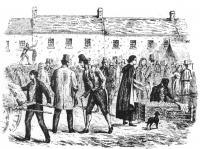
The Secret (from Trench ‘s Realities of Irish Life).
Short-term gains for small risks
But if the authorities congratulated themselves that repression had extinguished the movement, those who had participated in it were given little reason to shun collective action in the future. Against the high conviction rate recorded during the special commission must be set the fact that judicial penalties reached only a tiny fraction of the Terry Alts and their legions of supporters. Nor was the failure to achieve sweeping economic gains likely.to constitute a weighty discouragement to renewed activity. The decline in potato-ground rents and the increase in the area of land let in conacre were neither permanent nor long-lasting. But for poor people, or those made poor by the vagaries of the weather and by adverse market forces , short-term gains were matters of major consequence, casting in the shade the relatively small risks involved. The whole history of Whiteboyism in pre-famine Ireland shows conclusively that agrarian rebellion was a fairly low-risk strategy, and that those who pursued it were usually content with temporary gains.
Class solidarity and sectarian consciousness were clearly powerful cohesive factors among the Terry Alts. In its most developed phase their’s was essentially a movement of the rural and town poor against the better-off farmers and graziers. This was true even though many of the victims of the Terry Alts were landless or land-poor like themselves, such as ‘strange’ labourers and herds. And it was true even though the sons of farmers once again played a significant role. Communal youth groups were based less on class than on kinship ties and neighbourhood allegiances, and the neighbourhood links often produced alignments in agrarian collective action that defy neat categorisation in economic terms. But after these allowances have been made, the Terry Alt movement must be ranked as one of the most dramatic examples of class conflict in the pre-famine period.
James S. Dannelly, Jr. is Professor at Histary at the University af WiscansinMadisan.
Further reading:
T. Bartlett, The fall and rise of the Irish
nation: the Catholic question 1690-1830
(Dublin 1992).
S. Clark, Social origins of the lrish land
war (princeton 1979).
S. Clark and 1.5. Donelly, Jr. (eds.), Irish
peasants: violence and political unrest
1780-19l4 (Manchester 1983).
T.P. Power, Land, politics and society in
eighteenth-century Tipperary (Oxford
1993).






















